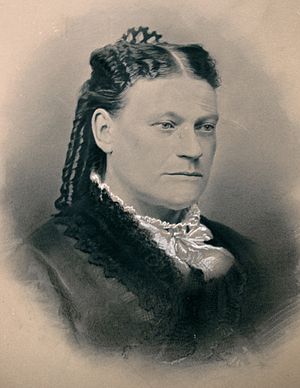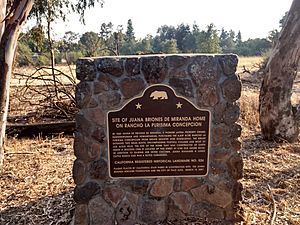Juana Briones de Miranda facts for kids
Juana Briones de Miranda (born around 1802 – died 1889) was an amazing woman from early California. She was a rancher, a healer, and a businesswoman. Many people call her the "Founding Mother of San Francisco" because she helped build the city when it was known as Yerba Buena. Later in her life, she also played a big part in developing what is now Palo Alto.
Contents
Early Life and Family
Juana Briones y Tapia was born around 1802 in a place called Villa Branciforte, near Mission Santa Cruz. Her family was mixed-race, with Native American, African-American, and European (Spanish) roots. Her grandparents and parents came to California with important expeditions led by Gaspar de Portolà and Juan Bautista de Anza. Juana's father, Marcos Briones, was a soldier who lived near Monterey and later at the San Francisco Presidio.
In 1820, Juana married a soldier named Apolinario Miranda. They had eleven children, and seven of them lived to be adults. They also adopted an orphaned Native American girl.
Life as a Pioneer and Healer
Juana and her family started a farm near El Polín Spring in San Francisco. She also bought land and built a house in Yerba Buena, which is now the North Beach area of San Francisco. Juana was a natural entrepreneur. She sold milk and fresh food to sailors from whaling ships and other ships visiting the port.
Juana was not only good at business and farming. She was also known for being very welcoming and for her skills in herbal medicine and helping women give birth (midwifery). She taught her nephew, Pablo Briones, about medicinal arts. He later became known as the "Doctor of Bolinas" in California. Even though Juana never went to school and could not read or write, she was very wise and skilled.
Rancho La Purísima Concepción
In 1844, Juana separated from her husband and stopped using his last name. That same year, she bought a large piece of land, about 4,400 acres (18 square kilometers), from two Native Californians. This land was called Rancho La Purísima Concepción in Santa Clara County, covering parts of today's Palo Alto and Los Altos Hills.
For many years, from the late 1850s to the 1860s, Juana had to fight in court to keep her land in both San Francisco and Santa Clara counties. She won her battles with the help of her lawyer, Henry Wager Halleck. She sold some of her rancho land to the Murphy family, who came to California with the Stephens-Townsend-Murphy Party. She also gave parts of the land to some of her children.
Juana's Unique Home
A part of Juana's rancho home stood until 2011 in the hills above Palo Alto, California. While most of the house was built later, two walls in the oldest part showed a rare way of building. They used horizontal redwood boards filled with adobe (a type of mud brick). This method made her home very good at keeping warm or cool, like traditional adobe houses. It also protected the adobe from rain and earthquakes, which were common problems for adobe buildings.
The original home had a common layout for adobe houses: a row of connected rooms with a hallway outside. After a long legal fight, the house was taken down in June 2011. However, a section of the original wall was saved and moved to the California Historical Society in San Francisco. In 2014, they opened an exhibit about Juana Briones called "Juana Briones y Su California: Pionera, Fundadora, Curandera."
Legacy and Remembrance
Juana Briones died in 1889 near the city of Mayfield, which is now part of Palo Alto, California. She is buried at Holy Cross Cemetery in Menlo Park.
She left the rest of her rancho land to her children, who used their father's last name, Miranda. Juana's memory lives on in the Palo Alto area. There is a Juana Briones Elementary School, Juana Briones Park, and several street names that use "Miranda" or her children's first names. Early maps of Yerba Buena (the first settlement outside San Francisco's Presidio and Mission) even show an area called Playa de Juana Briones (Juana Briones Beach). A historical plaque in San Francisco's Washington Square also honors her.



